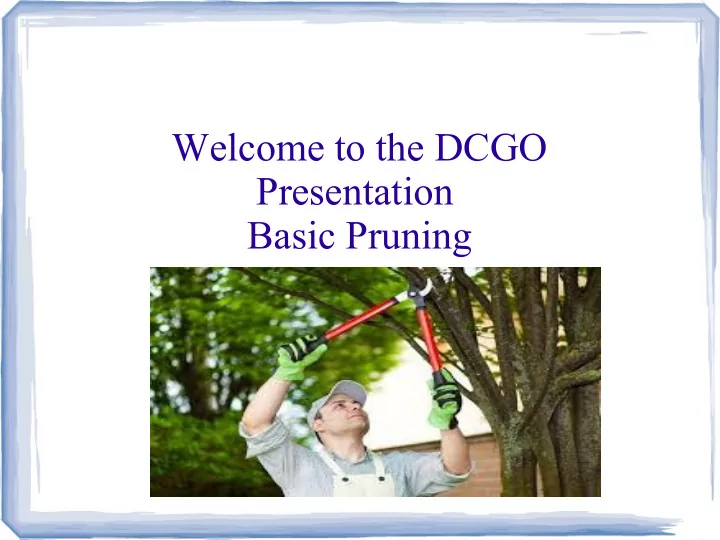

Welcome to the DCGO Presentation Basic Pruning
Agenda ● Reasons for Pruning ● Tools ● Safety ● Annuals ● Shrubs ● Trees ● Techniques
Why Prune ● Remove diseased vegetation ● Promote new growth ● Improve structural strength ● Increase bloom time ● Improve the appearance of the plant ● Reduce the size of the plant
Tools for Pruning ● Pruners ● Loppers – Long handles for leverage – Some have a ratchet to cut larger limbs ● Saws ● Hedge trimmers, not recommended ● Recommended Accessories – Gloves – Eye Protection – Disinfectant, cleaner
Pruners ● One or two edged ● Should be sharpened as necessary ● Clean and disinfect after each plant – More often if pruning out diseased vegetatio n
Saws ● Pruning saws – Folding – Fixed blade – Usually 8 to 12 inches – Can cut limbs 4 to 6 inches in diameter ● Pole saws aka pruning hooks – Fixed blade with a branch cutter – Usually have an extendable pole which may reach up to 14 feet – Electric saws are available ● Sawsalls can be used
Safety ● Use common sense ● Keep tools clean and sharp ● Wear eye protection and gloves ● Don't stand under branches being cut ● Be aware of surroundings – Watch out for spiders and biting/stinging insects
Pruning Annuals ● Also called dead heading ● Remove bloom after pollination and before seeds are mature ● Results in longer bloom period ● Flowers won't self seed
Pruning Perennials ● Timing depends on species of shrub – Flowering shrubs such as azaleas and forsythias prune soon after blooming ends – Others such as box wood and red tips prune in fall and winter ● Prune to a natural shape ● If doing a restoration prune take back to healthy, green, stems ● Cut perennial flowers back to close to ground level
Pruning Trees ● Diseased and dead wood can be cut out anytime ● Trees can be cut back less than 10% whenever needed ● Major pruning should be done when trees are dormant – Be aware that maple sap starts to run early ● Prune water sprouts ● Prune to allow branches sufficient space ● Know your limits – Pruning requiring climbing in the tree or large limbs is probably best left to pros
Pruning Techniques I ● Cut at a medium angle ● Prune near a bud next to the collar leave the bud intact ● A healthy tree should not be topped – Only top to remove storm damage – If necessary to lower the crown of the tree do a drop-crotch crown removal, cut back to existing large branches ● If branch is pruned correctly no sealer is needed.
Pruning Techniques II ● When pruning a large limb make a notch cut one or two feet away from the trunk first. Then make a cut at the collar ● Thinning is preferred to shearing – Cutting selected branches to a lateral branch, bud or main trunk – Encourages new growth in the interior – Shearing results on growth only at the exterior of the plant ● A cut branch will encourage growth on the side opposite the cut
Questions Handouts are available Thank you
Recommend
More recommend